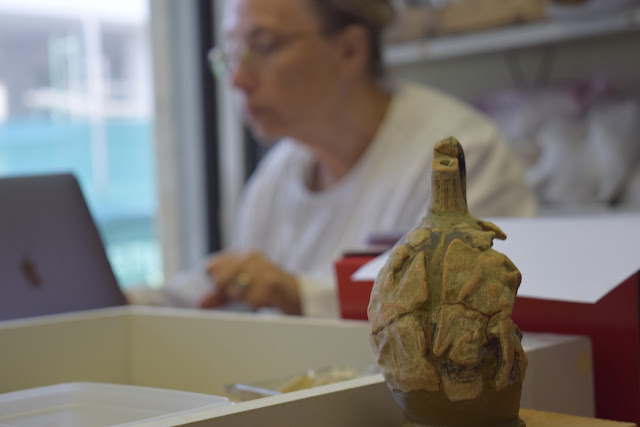The Darda Hill in Durrës (historically known as Dyrrachion), near the Brick Factory which uses the quality clay of the area, became densely populated after the 1990s. Archaeological findings, however, show that it has been populated even earlier and probably was one of the sacred places of ancient Durres. Thousands of small mature stone statues about 2600 years old were found on this hill in a massive discovery in 1970 by archaeologist Vangjel Toçi.
 |
| Site of Epidamnos at Durres, Albania [Credit: University of Cincinnati] |
The events did not come just as in the Euripides Hippolytus tragedy that talks about the rivalry between the two goddesses of Olympus, but were mainly developed at a close table at one of the offices of the Institute of Archaeology in Durres, 30 years after the shrine was found by Toçi. Ten archaeologists and scholars from Albania and France, led by French archaeologist Arthur Muller and Albanian artist Fatos Tartari, bowed for years over six tons of archaeological finds, including small figurines, ceramic pieces and coins.
“It’s a great discovery and there have never been so many terracotta figures with Greek figurines found,” said Muller.
Archaeologists believe they have reached the end of their work, and the model project that studied Artemis’s shrine has left in shelves hundreds of discovered and dated objects. Many of the pottery vessels were restored and coins were cleaned and rebuilt. Archaeologist Fatos Tartari said they are conducting a survey and looking for financial support to start publishing and hopefully have their first volume at the end of the year.
 |
| The clay figurine drawer of the Artemis goddess [Credit: Geri Emiri] |
This is just one of the answers archaeologists have received during the several year study. The team is also comprised by coin scholar Shpresa Gjongecaj, Belisa Muka who is a clay figurine researcher, Frederik Stamati who is a coin restorer, Avni Alcani who is a restorer of terracotta and figurines, archaeologist Eduard Shehi, antique art historian Marion Dufeu-Muller, Anne Tichit who is an antique ceramic researcher, and Stephanie Huyscom-Haxhi, a clay figurines researcher.
“Painted containers are reassembled. 650 coins have been mechanically and chemically cleaned. We cannot say how many pieces of ceramic or figurines have been restored because they have been in different volumes,” said Tartari.
The team also found that different from what was assumed, it was not Aphrodite who was worshipped, but Artemis. Tartari explained that they have antique texts which refer to Artemis in Durres. The ancient Appian author who wrote about the wars of Caesar and Pompeii in Durres, gives a passage that sent them to the Sanctuary of Artemis.
 |
| Earthen figurine from the Sanctuary of Artemis [Credit: Geri Emiri] |
Archaeologists believe that the women of the city were mainly on the shrine who, according to their social status, donated figurines made of muddy clay, in honor of the goddess Artemis, who emerged as a guarantor of well-being and marriage. Men are also believed to have donated figurines. According to archaeologists, their gifts differ as they are mostly miniature containers for keeping wine. They made the gifts after they got citizenship and tried to become part of the city’s society.
Editor's Note
The city was originally founded by Greek colonists from Corinth and Corfu under the name of Epidamnos (Greek: Επίδαμνος) around the 7th century BC and renamed Dyrrachion during the Roman and Byzantine periods. The Via Egnatia, the continuation of the Via Appia, started in the city and led across the interior of the Balkan Peninsula to Constantinople in the east. In the Middle Ages, it was contested between Bulgarian, Venetian and Ottoman dominions.
Source: Tirana Times [June 22, 2019]







No comments: